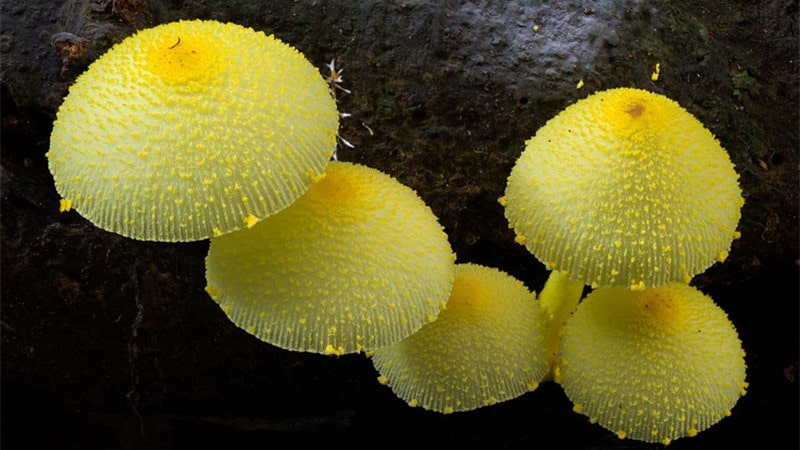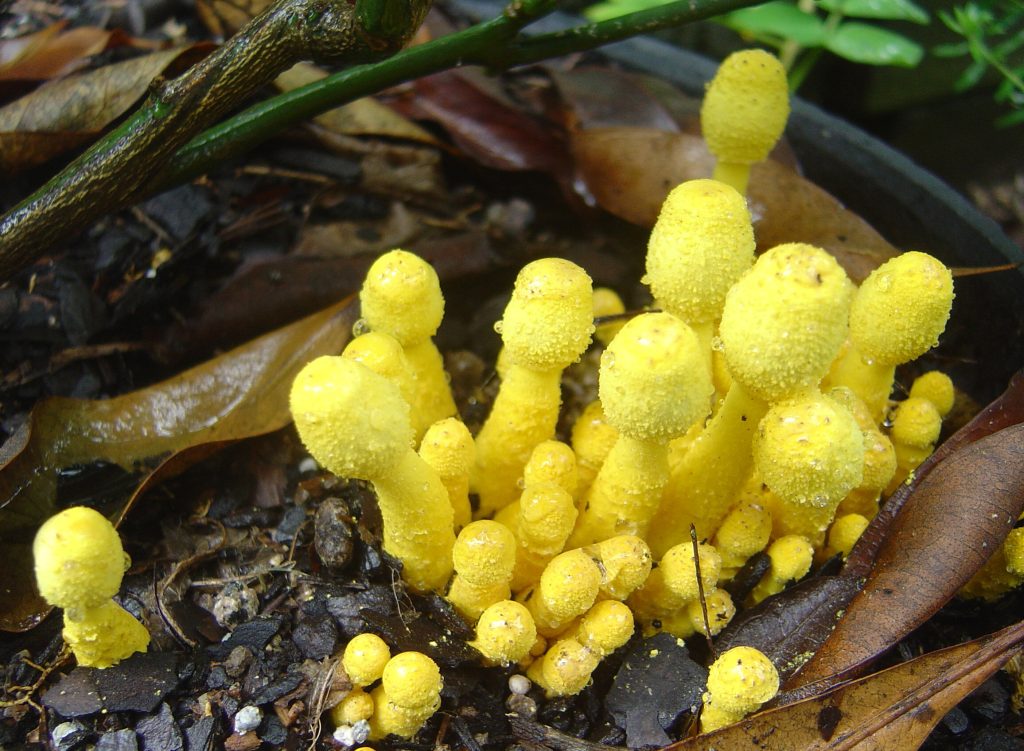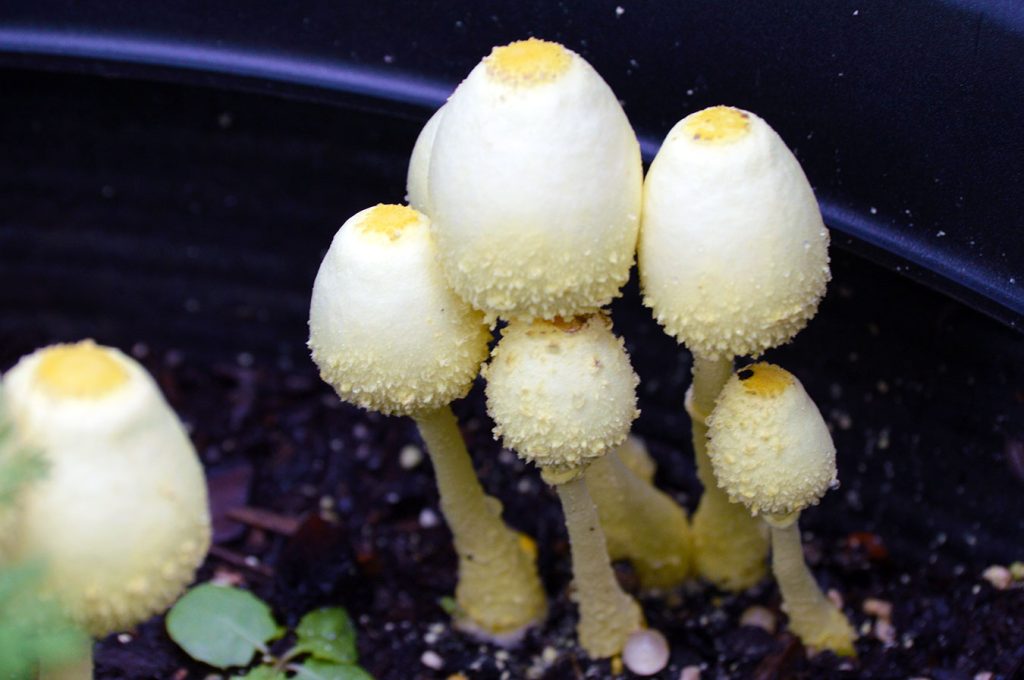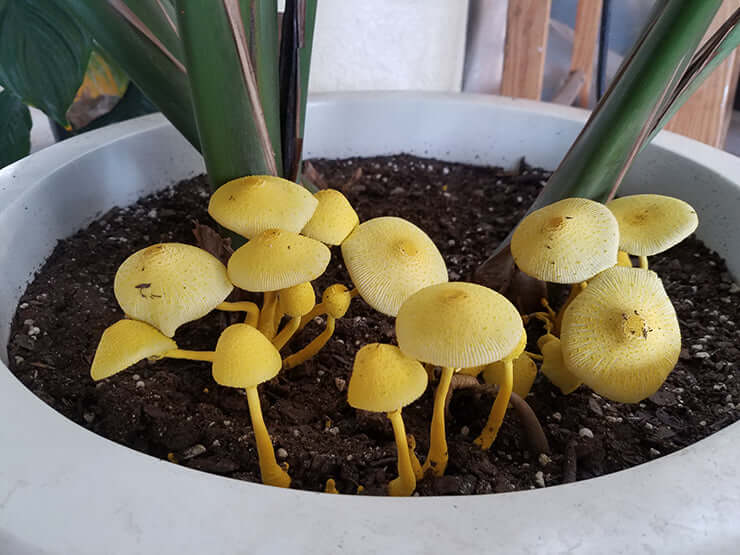Discovering tiny, golden mushrooms nestled within potted plants is a common occurrence. Yet, one might express concern when encountering these yellow stalks adorned with caps sprouting amidst their houseplants. These minuscule, yellowish mushrooms typically emerge in moist soil during warm and humid conditions. However, should one feel alarmed upon spotting mushrooms in their potted plants?
Fortunately, mushrooms in potted plant soil are generally nothing to fret over. Nevertheless, their presence might indicate the need to alter one’s approach to caring for houseplants. Fungi of all kinds thrive in damp, dim, and humid environments. Therefore, unless such conditions are the prescribed care requirements for the potted plants, a change in tactics is in order.
For instance, your prized houseplant may be susceptible to root rot resulting from overly saturated potting soil. Alternatively, a lack of sunlight may cause stress to the plant, rendering it vulnerable to pests and diseases. These undesirable circumstances pose a greater threat to indoor plants compared to the appearance of small, yellow mushrooms.
This article explores the causes behind the emergence of yellow and white mushrooms in potted plants. Additionally, it offers solutions to eliminate these unwanted fungi from your houseplants.
Yellow Houseplant Mushrooms

Yellow mushrooms flourishing within a houseplant container
Yellow mushrooms found in houseplant pots generally belong to the species Leucocoprinus birnbaumii, a type of gilled fungi belonging to the Agaricaceae family. These spongy, yellow mushrooms are commonly referred to as yellow parasols, plantpot dapperlings, flowerpot parasols, or lemon-yellow lepiota mushrooms. Some individuals simply refer to them as yellow houseplant mushrooms.
The yellow mushrooms in potted plants often start as light or pale-yellow patches on the surface of the potting soil. Subsequently, small clusters of mushrooms with rounded, umbrella-shaped, or conical caps begin to appear. Eventually, these mushroom clusters mature into a vibrant yellow hue, featuring multiple small fungi clustered together.
A cluster of Leucocoprinus birnbaumii mushrooms in a pot

Yellow houseplant mushrooms possess stems measuring 1″ to 3.5″ (2.5 – 9 cm) in length. The bulbous cap gradually transforms into a cylindrical shape, occasionally flattening. The lemon-yellow cap can span from 0.78″ to 3″ (2 – 7.5 cm) in width. Beneath the cap, sulfur-yellow gills can be found, which may darken to brown as the mushrooms age.
Two-day-old Leucocoprinus birnbaumii mushrooms in a flower pot, where they exhibit flat caps (Image)
Leucocoprinus birnbaumii is classified as a tropical or subtropical fungus species. Nevertheless, it is prevalent in temperate regions where it appears to materialize out of thin air within houseplant soil and greenhouses.
Microscopic spores present in the soil can remain dormant for several months before commencing their fruiting phase under favorable conditions. Hence, the sudden appearance of these small yellow mushrooms, despite the absence of any prior signs of a mushroom infestation in the plant soil.
Leucocoprinus birnbaumii mushrooms growing in potting soil

To some enthusiasts of indoor plants, the sight of small, vivid yellow mushrooms sprouting amidst potted plants is a thing of beauty. Since the mushrooms do not harm the plants, they are allowed to flourish. However, for others, these yellow mushrooms are seen as imposters that must be eliminated as a matter of priority.
White Mushrooms in Potted Plants
White mushrooms found in houseplant soil typically belong to the same species as the yellow mushrooms—Leucocoprinus birnbaumii. However, depending
on the growing conditions, these fungi can exhibit a pale yellow or nearly white appearance. These mushrooms also release white spores, which may resemble a fine layer of white dust on the plant soil.
The white mushrooms in potted plants may also be attributed to a related species, Leucocoprinus flavescens. These mushrooms feature a white cap with a brownish center and grow under the same conditions as their yellow flowerpot counterparts. Just like their yellow counterparts, they do not harm the plants.
When Do Mushrooms Appear in Potted Plants?
Yellow mushrooms in potted plants typically emerge during the summer months, around July and August. Summer provides optimal conditions within the soil for the fungal spores to thrive and bear fruit. During this period, household air tends to be moist, warm, and humid—creating the perfect environment for the growth of small yellow mushrooms in contaminated potting soil.
How to Identify Mushrooms in Potted Plants
Mushrooms growing indoors can be identified by their yellow color, cap shape, gill color, and size. Since Leucocoprinus birnbaumii is the most common yellow to pale-yellow mushroom found in potting soil, the species are relatively easy to distinguish. It is rare to encounter a different mushroom species within houseplant pots.
Where Do Mushrooms in Potted Plants Come From?
The origin of yellow mushrooms in houseplant soil is a frequently asked question, as the sudden appearance of these yellow fungal growths can be puzzling. The mushrooms sprout from microscopic spores or thread-like fungal roots (mycelium) present in the soil. These spores can remain dormant for months until the ideal conditions arise.
Typically, the fungal spores are already present in the houseplant soil mix at the time of purchase. Even in soilless potting mixes, these microscopic spores can be present. Once they find their way into the soil, eradicating them becomes challenging. Hence, the recent appearance of yellow mushrooms does not necessarily imply recent spore contamination.
Do Mushrooms in the Soil Benefit Potted Plants?
Mushrooms in potting soil can provide benefits to plants. Fungi aid in the decomposition of organic matter within the soil, supplying essential nutrients and enhancing soil structure. Moreover, the mycelium of mushrooms forms connections with the roots of plants, facilitating improved water absorption. For some houseplant owners, the presence of small yellow mushrooms adds aesthetic appeal to their indoor plants.
Clusters of yellowish mushrooms can contribute to plant health in two ways. Firstly, mushrooms can lower the pH level of the soil while increasing nitrogen and phosphate content, which are vital nutrients for robust plant growth. Secondly, mushrooms communicate through their interconnected mycelium, creating an underground network.
According to researchers at UCDavis, these underground signals can alert neighboring plants of potential threats, enhancing their defense mechanisms against parasitic fungal attacks. However, this benefit is primarily observed in plants growing in close proximity to one another. It highlights the positive effects of mushrooms on houseplant soil.
Are Mushrooms Harmful to Potted Plants?
Mushrooms do not pose harm to potted plants. Unlike other types of fungal infections, mushrooms play a crucial role within the soil’s ecosystem. They contribute to the decomposition of decaying organic matter, such as old leaves or roots, while replenishing the soil with beneficial nutrients for plant nourishment.
Contrary to popular belief, yellow and white mushrooms in plant pots do not compete for the same nutrients in the soil since they absorb different elements compared to houseplants. Thus, rather than causing harm, these mushrooms are advantageous to the overall well-being of the plants.
Although the presence of mushrooms in plant pots does not harm the houseplants themselves, it could indicate underlying issues that pose a threat to plant health. For example, house
plant mushrooms thrive in moist conditions, contrary to the requirements of most houseplants. Therefore, their presence may indicate overwatering.
Indoor plants are susceptible to excessive moisture, resulting in saturated soil or damp environments. To mitigate the risk of fungal or bacterial root diseases, it is advisable to limit watering to when the top 1″ to 2″ (2.5 – 5 cm) of soil has dried out. This approach safeguards houseplants from potential harm caused by mushrooms and maintains optimal soil conditions.
Hence, removing the mushrooms from the potting soil is typically unnecessary to promote plant health. Instead, consider adjusting your houseplant watering schedule, improving soil drainage, or relocating the plants to sunnier spots.
What To Do About Potting Soil with Mushrooms
In general, there is usually no need to take action concerning the presence of yellow mushrooms alongside potted plants. These yellow fungi can enhance the visual appeal of plants, and if your houseplants require moist soil, their presence indicates the plants are thriving.
However, if unwanted guests are not welcome in your plants, you can manually remove them by carefully digging up the roots and disposing of the fungi. It is important to note that this may not eliminate them entirely since the gills on the underside of mushroom caps release microscopic spores, which can give rise to new fungi under suitable conditions.
Are Mushrooms Growing in Potted Soil Harmful to People?
It is crucial not to consume Leucocoprinus birnbaumii mushrooms as they are poisonous to both humans and pets.
Yellow mushrooms pose no harm to humans upon contact. However, it is important to note that Leucocoprinus birnbaumii mushrooms are considered toxic. Therefore, consumption of these yellowish growths should be avoided.
According to Iowa State University, ingesting these mushrooms can result in poisoning. While consuming the mushrooms may not be fatal, it can cause gastrointestinal discomfort, vomiting, and diarrhea.
Therefore, it is advisable to remove plantpot dapperling mushrooms from potted plants, particularly if there are children or pets in the vicinity. However, it is worth noting that simply touching the mushrooms will not cause harm.
Can Mushrooms in Potting Soil Harm Pets?
If cats or dogs ingest the fruiting bodies of yellow mushrooms found in indoor plant pots, they can experience adverse effects similar to those observed in humans. Pets may develop stomach pain, diarrhea, and vomiting.
Six Reasons Mushrooms Grow in Houseplant Soil
Determining how fungus spores infiltrated the plant soil can be challenging. Yellow mushrooms may appear even if fungi had not been present in previous years. In many cases, the exact cause behind their sudden growth remains uncertain. However, there are six common ways this occurrence can be explained:
1. Excess humidity can lead to mushroom growth in potted plants.
Yellow flowerpot mushrooms thrive in humid conditions when the soil retains excessive moisture. They are often found in potted plants within regions that experience high humidity during summer. As a result, small, round, yellowish growths may emerge in potting soil during July and August. The use of a humidifier for houseplants can further create favorable conditions for mushroom growth.
2. Utilizing garden soil in plant pots.
It is essential to avoid using garden soil for houseplants. Garden soil contains both beneficial and harmful microbes, including countless fungal spores. Instead, opt for commercial potting mixes suitable for your specific plants. Alternatively, you can create your own DIY potting mix tailored to different types of houseplants.
3. Overwatering.
Overwatering houseplants can trigger the sudden growth of flowerpot parasol mushrooms. Excessive soil moisture and warm ambient temperatures provide an ideal environment for the development of fruiting bodies. However, mushrooms should not be a primary
concern when dealing with overwatering. The real risk lies in the potential development of root rot in houseplants sitting in overly saturated soil.
If signs of root rot, such as poor growth, yellowing leaves, or wilted brown leaves, become apparent, immediate repotting is necessary. Check the roots for mushy, brown sections and remove them as needed. Subsequently, repot the plant using fresh potting soil.
To prevent future moisture-related issues, water houseplants only when the top layer of soil has dried out. This practice not only prevents root rot but also discourages mushroom growth.
4. Contaminated potting soil may contain fungal spores.
One possible reason for the growth of yellow mushrooms in potted plants is contaminated soil. Even soilless potting mixes can harbor microscopic spores, lying dormant until conditions become suitable for fruiting.
5. Introduction of mushroom spores into the soil.
The sudden appearance of yellow mushrooms in potting soil can be attributed to spores carried from other sources. Mushrooms release microscopic spores that can be transported by wind or attached to clothing. In humid climates, spores may enter through open windows or may have been present in the plant from the moment of purchase.
6. Richness of potting soil.
While the presence of mushrooms in potting soil is indicative of soil fertility, it may also be due to an excessively nutrient-rich mix. Rather than being a negative sign, it signifies an abundance of nutrients that support both plant growth and mushroom development.
How to Get Rid of Mushrooms in Potted Plants
Removing mushrooms from potted plants can be achieved through manual extraction, soil replacement, and adjustments to watering techniques. Let’s delve into these methods in more detail.
Handpicking mushrooms to eliminate them from houseplant pots
The simplest way to remove yellow mushrooms is by manually plucking them. Utilize a small trowel to extract as much of the fungal roots as possible from beneath the soil surface. Place the mushrooms in a sealable bag and dispose of them in the trash.
It is advisable to remove the mushrooms while the yellow cap is still bulbous and before it fully opens, as this stage is when the dispersal of spores occurs, facilitated by the umbrella-shaped or parasol cap.
Repotting the houseplant with fresh soil
If yellow mushrooms persistently reappear year after year in your houseplants, it may be necessary to completely replace the potting soil. Purchase a new soil mix from a reputable supplier to ensure its quality. Be cautious when removing the plant from the contaminated soil to minimize spore dispersion.
After discarding the old soil, thoroughly clean the pot using soapy water to remove any traces of fungal spores. Proceed to repot the plant using fresh potting soil.
Unfortunately, this measure may not entirely eradicate the issue of mushrooms in potted plants, as spores may still be present on parts of the plant’s roots.
Removing the top layer of soil to eliminate mushrooms from potted plants
For those unwilling to repot the plant, it is possible to replace the top layer of soil. Remove the top 2″ (5 cm) of soil and replace it with fresh potting mix. However, this method is often ineffective in completely halting mushroom growth if the mycelium is deeply embedded in the soil surrounding the roots.
Adjusting watering schedule, temperature, and humidity
Yellow mushrooms require specific conditions to thrive. Therefore, spores remain dormant in the soil until temperature, humidity, and soil moisture levels become favorable. By properly watering houseplants and maintaining moderate humidity levels, the growth of yellow mushrooms can be prevented.
To prevent yellow mushroom growth, adhere to the practice of watering houseplants only when the top layer of soil is dry. This approach prevents root rot and discour ages mushroom development.
How to Prevent Mushrooms Growing in Potted Plant Soil
The best way to prevent the growth of yellow, conical-capped mushrooms in potted plants is to maintain slightly dry soil conditions.
The ideal watering technique for potted plants is to wait until the top 2″ to 3″ (5 – 7.5 cm) of soil has dried out. Subsequently, thoroughly saturate the soil until water drains from the pot’s drainage holes. Allow the excess water to drain completely before returning the plant pot to its drip tray or saucer.
